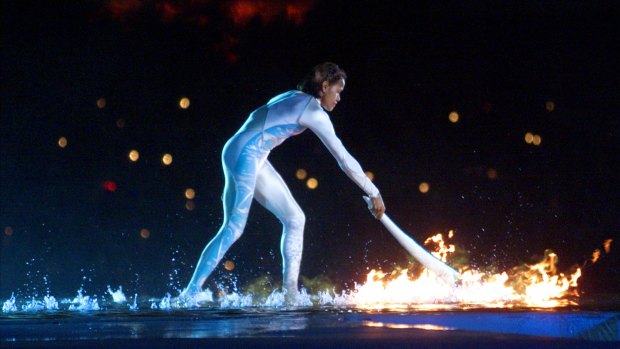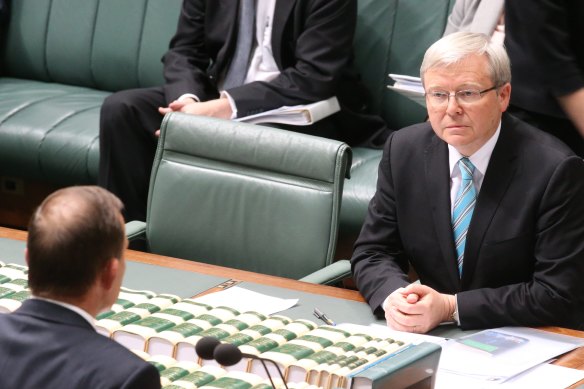Save articles for later
Add articles to your saved list and come back to them any time.
As the Olympic flame was extinguished at the conclusion of the 2000 Sydney Games, former Labor prime minister Paul Keating could not decide in which direction Australia was heading.
“I left Homebush on the night of the closing ceremony uncertain whether I had just seen the beginning of something new,” he revealed a couple of months afterwards in a lecture marking the centenary of Federation, “or the concluding fireworks of the period of reform and ambition in Australia in the 1980s and 1990s.”
How to reignite the flame of reform. The last significant example was the introduction of the GST in 2000, the year Cathy Freeman lit the flame at the Sydney Olympics.Credit: Victoria Arocho
Arguably, the curtain had already come down on the Australian reform era of which Keating was such a central figure. The GST, the last landmark economic reform, came into operation under the Howard government in July 2000, a couple of months before athletes flew into Sydney. In the 1999 republic referendum, not a single state voted yes to ditching the British monarchy.
John Howard, in the latter half of his 11 years in office, often seemed to simultaneously perform a dual role as prime minister and opposition leader. Whether it was refusing to ratify the Kyoto climate change agreement or rejecting appeals to apologise to Indigenous Australians for past injustices, Howard said “no”.
“A conservative is someone who stands athwart history, yelling stop,” the American right-wing intellectual William F Buckley Jr once noted, a phrase that was especially resonant here in Australia at the fag end of the Howard era. Despite enacting his unpopular WorkChoices legislation, the country’s second-longest-serving prime minister was defined towards the end of his tenure more by what he opposed than what he proposed.
It was indicative of the oppositional tenor of the times that even amid the excitement of the Kevin ’07 election, the Labor leader’s most ringing campaign line came when he pledged not to do something. “I have no intention today of repeating Mr Howard’s irresponsible spending spree,” Kevin Rudd proclaimed at Labor’s campaign launch in November 2007, seemingly trying to out-conservative his arch-conservative opponent. “Today I am saying loud and clear that this sort of reckless spending must stop.”
The opposition leader Tony Abbott faces off against prime minister Kevin Rudd in 2013. Abbott “seemed to relish standing athwart history yelling stop”.Credit: Andrew Meares
The turning point of Rudd’s truncated first term – and a sliding-doors moment for Australian politics more broadly – came with his retreat on his supposed signature reform, the emissions-trading scheme. The bipartisanship on the ETS offered by then Liberal leader Malcolm Turnbull collapsed with his ouster by Tony Abbott. On Abbott’s first full day as opposition leader, the Greens joined with the Liberals to defeat Rudd’s Carbon Pollution Reduction Scheme. Rudd never recovered. Nor did Canberra politics.
More so than reform, Australian politics has come to be defined by retreat, revenge and regression. Regular leadership spills. Climate wars. Culture wars. Vacuous sloganeering, which has dumbed down democracy. Small-target campaigning. A reluctance to engage in bipartisanship that grants a political win to the government of the day. Policy stasis. The 2022 election, a contest between an exhausted government that had run out of ideas and an opposition with a meagre menu of policy, highlighted the sense of inertia.
Clearly, there has not been complete gridlock over this entire period. Julia Gillard, at the head of a minority government, managed to legislate a carbon price, and also enacted the National Disability Insurance Scheme. But Gillard was knifed by Rudd, who was then beaten at the 2013 election by Tony Abbott, who personified the politics of No. Abbott seemed to relish standing athwart history yelling stop, a role he resumed in the Voice referendum.
When the “wonder from Down Under” economy was humming along, this was not such a problem. In the early part of the century, the country benefited still from the Australian model created during the reform era, which, along with the resources boom, helped it withstand the shocks of the Asia financial crisis and the great recession. But now an increasingly outdated model is in need of repair and renewal.
This was the theme of a speech delivered by Professor Richard Holden of the University of NSW at the National Press Club last week. “Our inability to make major reforms is a significant risk,” Holden said. “Every year that we are unable to enact important reforms increases the chance of a recession if we are hit by a global or domestic shock.”
Australia’s economic exceptionalism, which produced those three recession-free decades, has camouflaged a quarter-century of policy underachievement.
Negativity begets negativity. Peter Dutton’s reaction to the Voice referendum, with the jettisoning of his offer for a referendum on recognition, suggests he will become even more oppositional. Abbott says he is “getting a little bit sick” of welcome-to-country ceremonies. The danger is that Australia will venture further down a destructive and polarising path, not to the nihilism of US Republicans but to the point where Liberal politics especially is defined first and foremost by what it is against.
For decades henceforth, we will debate how the soft Yes suggested by polling a year beforehand became the hard No of the referendum vote, but the relentlessly oppositional politics that has become the defining characteristic of 21st century Australian politics will feature heavily in the reckoning.
Nick Bryant is the author of The Rise and Fall of Australia: How a Great Nation Lost Its Way.
Most Viewed in Politics
From our partners
Source: Read Full Article




